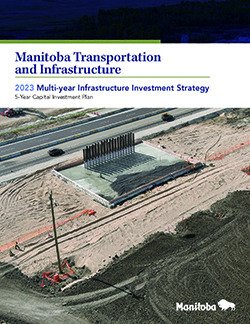2023 Multi-Year Infrastructure Investment Strategy
The 2023 Multi-year Infrastructure Investment Strategy provides a five-year plan that details Manitoba Transportation and Infrastructure’s (MTI) plans to invest in new and existing highway, water, airport and general assets. Planned strategic investment in roads, highways, bridges, airports and flood protection over the next five years totals over $4.1 billion dollars and represents MTI’s commitment to building our economy and investing in Manitoba’s future.
The 2023 Multi-year Infrastructure Investment Strategy will, for the first time, expand beyond highways to include MTI’s other assets and related projects. Overall, the new investment strategy is intended to provide a more comprehensive picture of the department’s project planning initiatives. This five-year investment strategy for capital investments brings a positive and transparent collaboration with MTI’s stakeholders that is crucial to our department’s work toward improving infrastructure across the province.
The investment strategy focuses on a number of key initiatives, with projects organized to reflect the investment categories of infrastructure renewal, economic development, climate resiliency and connectivity and innovation. These investments will strengthen and complement existing projects, including projects within the Trade and Commerce Grid Initiative, the Winnipeg One Million Perimeter Freeway Initiative, the proposed Lake St. Martin and Lake Manitoba Outlet Channels and the twinning of the Trans-Canada Highway to the Ontario border.
2023 Multi-year Infrastructure Investment Strategy (PDF)
2023 Multi-year Infrastructure Investment Strategy Highlights
MTI is undertaking a range of strategic initiatives to support government’s vision of growing Manitoba as a transportation hub that better enables trade access to markets and supports investment in trade-based industries. This includes strategic initiatives for highways related to the National Trade Corridors Strategy, the Trade and Commerce Grid Initiative and the Winnipeg One Million Perimeter Highway Freeway Initiative. These initiatives are used to guide the development of the highway capital plan and prioritization of investments.
The National Trade Corridor Strategy
The National Trade Corridor Strategy aims to improve the fundamental safety and fluidity basis of Manitoba’s most critical trade and travel corridors. The initial focus will be on the twinning of PTH 1 (the Trans-Canada Highway) from Falcon Lake to the Ontario border, with additional corridors to be evaluated for future improvements under this strategy.
In alignment with this strategy, MTI is also committed to northern economic corridor development, positioning development of a sustainable northern corridor through the Port of Churchill, including enabling the potential for export of key resources such liquefied natural gas (LNG). This includes a $74-million capital investment in the Hudson Bay Railway.
Trade and Commerce Grid Initiative
The Trade and Commerce Grid Initiative allows MTI to:
- expand its interconnected grid of key north-south and east-west corridors that support RTAC loading, Manitoba’s heaviest regulated loading classification
- continue to build and maintain a robust highway network that supports the economy by enabling access to international and interprovincial markets
- identify alternative RTAC routes where existing RTAC highways are vulnerable to the effects of climate change
- prioritize highway investments that best support Manitoba’s economy
Winnipeg One Million Perimeter Freeway Initiative
Residential, commercial and industrial growth in the City of Winnipeg and surrounding communities has demonstrated the need to create a safer and more efficient Perimeter Highway (PTH 100 and PTH 101). Upgrading the Perimeter Highway to freeway standard requires a combination of safety improvements and interchange construction, including the removal of at-grade crossings, the addition of interchanges or overpasses at all intersecting roadways and railways, and the reconstruction of pavements and some major structures.
Climate Resiliency
Flooding along rivers, lakes, creeks and streams is a natural occurrence in Manitoba that can occur any time of year. While flooding cannot be prevented entirely, Manitoba is protected by extensive flood infrastructure that helps to lessen potential damage to people and property.
The Lake Manitoba and Lake St. Martin Outlet Channels initiative is ongoing and once complete, will enhance flood protection to communities around Lake Manitoba and Lake St. Martin and help to strengthen Manitoba’s existing network of flood mitigation infrastructure.
The 2023 Multi-year Infrastructure Investment Strategy supports flood protection, mitigation and recovery projects throughout the various programs.
Further details on these strategies and initiatives are provided in the Multi-year Investment Strategy document and additional project information can be found on the department’s Manitoba Infrastructure Projects Map. The map is an online geographic information system (GIS) web-service application with an interactive map that allows the public access to capital project information on the Manitoba highway network.
The mapped location and status of projects that are currently included in the 2023 Multi-year Infrastructure Investment Strategy are located here: Manitoba Infrastructure Projects Map
To request this information in an alternate format, please contact icp@gov.mb.ca
Previous years
2022 Multi-Year Highways Investment Strategy (PDF)



